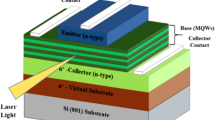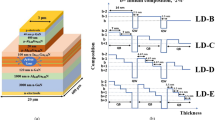Abstract
We have calculated the electronic band structure and polarization dependent optical gain in a strain balanced SixGeySn1−x−y/GezSn1−z based transistor laser (TL) with GezSn1−z single quantum well (QW) in the base. Design consideration for QW is also addressed to ensure moderate carrier and optical confinement. A significant TE mode optical gain is obtained in mid infra red region for the transition of Г valley conduction band to heavy hole valence band. Optical gain in the QW plays an important role in determining the optical characteristics of Tin (Sn) incorporated group IV material based TL.






Similar content being viewed by others
References
Chang, G.E., Chang, S.W., Chuang, S.L.: Strain-balanced multiple-quantum-well lasers. IEEE J. Quantum Electron. 46(12), 1813–1820 (2010)
Chuang, S.L.: Physics of photonic devices, 2nd edn. Wiley, New York (2009)
Coldren, L.A., Corzine, S.W., Mashanovitch, M.L.: Diode laser and photonic integrated circuits, 2nd edn. Wiley, New york (2012)
Das, M.K., Ranjan, R.: Theoretical estimation of optical gain in Tin-incorporated group IV transistor laser.Proc. of Int. Conf. NUSOD Post-Deadline Paper, 9–10 (2015)
Datta, S.: Quantum transport:atom to transisitor. Cambridge University Press, New York (2005)
Goodman, C.H.L.: Direct-gap group IV semiconductors based on tin. IEEE Proc. I: Solid State Electron Devices 129, 189–192 (1982)
Feng, M., Holonyak Jr, N., Walter, G., Chan, R.: Room temperature continuous wave operation of a heterojunction bipolar transistor laser. Appl. Phys. Lett. 87, 131103 (2005)
Feng, M., Holonyak Jr, N., Then, H.W., Walter, G.: Charge control analysis of transistor laser operation. Appl. Phys. Lett. 91, 053501 (2007)
Fischetti, M.V., Laux, S.E.: Band structure, deformation potentials, and carrier mobility in strained Si, Ge, and SiGe alloys. J. Appl. Phys. 80, 2234–2252 (1996)
Holonyak Jr, N., Feng, M.: The transistor laser. IEEE Spectr. 43, 50–55 (2006)
Kouvetakis, J., Menendez, J., Chizmeshya, A.V.G.: Tin-based group IV semiconductors: new platforms for opto- and microelectronics on silicon. Annu. Rev. Mater. Res. 36, 497–554 (2006)
Kurdi, M., El, T., Kociniewski, T.-P., Ngo, J., Boulmer, D., Débarre, D., Boucaud, P., et al.: Enhanced photoluminescence of heavily n-doped germanium. Appl. Phys. Lett. 94, 191107 (2009)
Menendez, J., Kouvetakis, J.: Type-I Ge/Ge1−x−ySixSny strained-layer heterostructures with a direct Ge Bandga. Appl. Phys. Lett. 85(7), 1175–1177 (2004)
Oeheme, M., Kostecki, K., Schmid, M., Oliveria, F., Kasper, E., Schulze, J.: Epitaxial growth of strained and unstrained GeSn alloys up to 25 % Sn. Thin Solid Films 557, 169–172 (2014)
Soref, R.A., Perry, C.H.: Predicted band gap of the new semiconductor SiGeSn. J. Appl. Phys. 69, 539–541 (1991)
Van de Walle, C.G.: Band lineups and deformation potentials in the model-solid theory. Phys. Rev. B 39(3), 1871–1883 (1989)
Werner, J., Oehme, M., Schmid, M., Kaschel, M., Schirmer, A., Kasper, E., Schulze, J.: Germanium-tin pin photodetectors integrated on silicon grown by molecular beam epitaxy. Appl. Phys. Lett. 98, 061108 (2011)
Acknowledgments
This work is partly supported by UGC, Govt. of India through the SAP Project Grant for the Department of Electronics Engineering in the thrust area, Modeling of Semiconductor Nanostructured Devices.
Author information
Authors and Affiliations
Corresponding author
Additional information
This article is part of the Topical Collection on Numerical Simulation of Optoelectronic Devices, NUSOD’ 15.
Guest edited by Julien Javaloyes, Weida Hu, Slawek Sujecki and Yuh-Renn Wu.
Rights and permissions
About this article
Cite this article
Ranjan, R., Das, M.K. Theoretical estimation of optical gain in Tin-incorporated group IV alloy based transistor laser. Opt Quant Electron 48, 201 (2016). https://doi.org/10.1007/s11082-016-0459-4
Received:
Accepted:
Published:
DOI: https://doi.org/10.1007/s11082-016-0459-4




